Ramen is taking over the world. It’s hearty, it’s got flavour, there’s a dynamic range of textures, and it’s simple yet complex at the same time. In order to truly understand the Japanese favourite comfort food, one has to make a pilgrimage to where this simple bowl of soup, noodles, and toppings began. There’s no doubt that the capital of Japan is home to the best food and so this is where I recommend that you start your tour of the best ramen in Tokyo, Japan.
This guide is going to focus on the ramen itself and not so much the travel behind going to each spot. That said, I will be dropping a ton of detail for each restaurant, why it’s a must-visit, what to order, how to get there, and insider tips you won’t find anywhere else.
Read more about Japan
- Ramen etiquette you need to know about before going to Japan
- 12 Day Japan Itinerary
- Ultimate Tokyo Food Guide
- How To Get Around Tokyo
- Tasty food souvenirs from Japan
How to get the best deals in travel
- Hottest deals – Bookmark the travel deals page.
- Car rentals – stop getting ripped off and learn about car rental coupon codes.
- Hotels – Use corporate codes or get Genius 2 tier with Booking.
- Flights – Have you ever heard of the “Everywhere” feature?
- Insurance – Make sure you’re covered and learn more about where to buy the best travel insurance.
What You’ll Find in This Tokyo Ramen Food Guide
In This Article
I hope you’re hungry because I am!
Finding the Best Ramen in Tokyo
If there’s anything that I learned from the 9 Must Eat Restaurants in Tokyo video, it’s that picking anything “best” or “top” in a city like Tokyo is a set up for failure and trolling (it is YouTube after all). While I loved what I produced there and stand by all of my recommendations in my ultimate Tokyo food guide, I knew this time, I had to do it a little differently.
WARNING: You may be ruined for ramen forever after this.
To find that perfect bowl of ramen, I knew I had to experience it in an authentic, and totally local way. That’s when I found out about Ramen Beast.
No, this isn’t a half-human half-mystical monster crushing bowls of ramen left, right, and centre (despite the home page contradicting this very sentence) but this is in fact a collective of serious ramen foodies that have come together to create a central hub for ramen in Japan in English. They have a Ramen Beast app to make it even easier when you’re on the ground in Japan and on top of that, they also offer ramen tours in Tokyo.

With Hiroshi Shimakage as the local expert with us and helping with the selections, we embarked on a one-of-a-kind ramen experience.
Ramen Etiquette
Before you go to Japan, make sure you read this primer on ramen by learning the proper way to eat ramen and etiquette that goes unspoken.
8 of the Best Ramen in Tokyo

As I mentioned, when it came to building a list of the “must visit” ramen Tokyo, it seemed like a thankless task. Luckily, with the expertise of Hiroshi-san, he was able to put together a stellar line up of ramen joints that are truly world-class.
The key for me was to be able to judge the ramen by the quality of the ingredients, overall taste, presentation, and to a lesser extent the ambiance. What made that difficult was the fact that I also wanted to put together a list of the best ramen in Tokyo that could be strung together as tour as well and with that, it meant I was looking for a variety in terms of the types of ramen.
Without further ado, here are the 8 of the top ramen restaurants in Tokyo, Japan that I highly recommend. The order that they are listed is an indication of how I would rank them.
1. Konjiki Hototogisu (金色不如帰(コンジキホトトギス))

Let’s start off with the obvious here. There are only 3 ramen shops that have a Michelin star and this is one of them. What makes that special is that it is one of the most affordable Michelin star restaurants (if you don’t include something like Tim Ho Wan in Hong Kong) in the world. For 1,000 JPY (less than $10 USD), you’re getting a masterpiece in a bowl and here’s why.

What makes this bowl of ramen a cut above the rest is its delicate balance of ingredients that dance together so well. More importantly, it packs an unexpected twist that you just can’t find anywhere else.
If you’ve watched the video above, you’ll know that there’s an endless list of features in the shoyu. The first part is the triple soup that uses a clear pork broth, Wa-dashi, and hamaguri clam dashi. It’s then topped with homemade truffle sauce, porcini oil and flakes. If that wasn’t enough, they make their own noodles homemade and in-house (the close room you’ll see in the shop). Finally, you have the sous-vide pork which is just ridiculously well done and I loved the menma they used as well.
Somehow the clams and the truffle work so well together – unexpected and wonderful
The restaurant is designed in a unique way that definitely maximizes on the limited footprint it has. With light Japanese pop playing in the background, it’s got the warm touches of the light birch tones balanced with the contemporary textured greys and the stainless steel of the kitchen.

Much larger than its original shop, this one boasts 7 seats at the bar with details like the table that’s made out of one piece of wood and 4 more seats to the left in its own nook. Unlike most ramen shops, there’s also another section with a bench that’s for waiting. The other thing that you’ll notice is that the ledge above the bar is quite high which means you won’t see any of the action in the kitchen besides the floating heads of the chefs moving back and forth. If there’s a knock on anything in the restaurant it’s probably that because it does feel a little less personal.
Not seeing what’s happening behind adds to the mystique of the whole experience because you can’t see what actually goes into the making of the bowl. The anticipation is so high and once you have it in front of you and you start chowing down, you can’t help but smile and go “WOW”!
Wondering if they have Konjiki elsewhere in the world? They also have shops in Singapore and also my home town of Toronto with 4 Konjiki locations.
What You Need To Know
Opened: 2006
Ramen master: Yamamoto-san (not likely to be at the shop)
Seats: 11
Neighbourhood: Shinjuku
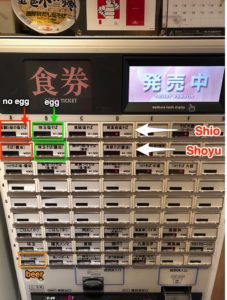
Open hours: 11:30AM-3PM, 6:30PM – 9:30PM, Closed Mondays and Weekends
Best time to go: Best bet is to show up 30 minutes before opening of the two serving times
Address: Japan, 〒160-0022 Tōkyō-to, Shinjuku City, Shinjuku, 2-chōme−4−1 第22宮庭マンション1F
Closest metro station: Shinjuku-Sanchome Station
Price: Shoyu (850 JPY – $7.74 USD), Shio (900 JPY – $8.19 USD), Shoyu with egg (950 JPY – $8.65 USD), Shio with egg (1,000 JPY – $9.10 USD)
English menu?: Yes
Ordering machine: Maximum 2,000 JPY bills, no pictures and Japanese only. English menu has machine instructions however
What to order: Both the shoyu and shio ramen are superb. This is a good spot to order ajitama (egg) as well
Photography: There are signs that explicitly say not to take photos or videos of the kitchen, staff or other customers which is common ramen etiquette. They seem more strict than most
2. Ramenya Toybox (ラーメン屋トイ・ボックス)
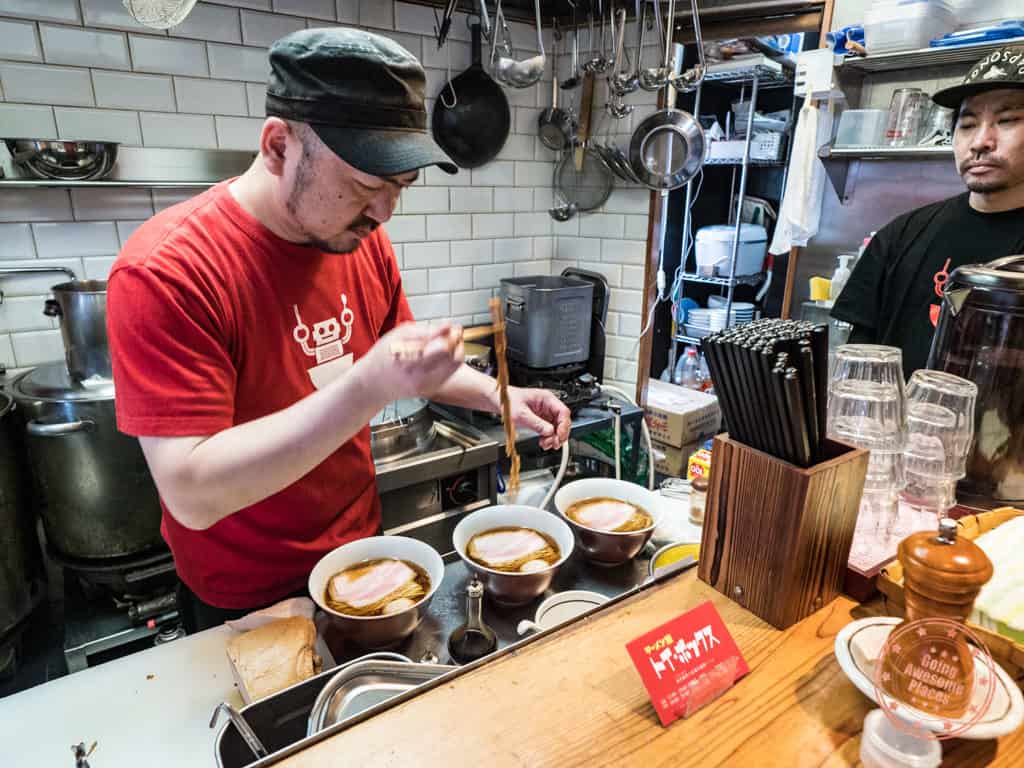
This unassuming corner ramen shop in the quiet neighbourhood of Minowa might not look like much but trust me, Toybox is the epitome of perfection and why it has high praise to be recommended in Michelin’s Bib Gourmand.
With only 8 seats that wrap around the corner of what is literally a tiny box, I equate the intimate experience to being an audience surrounding an orchestra conductor performing at his or her peak. Truly, playing in his “toy box”, Yamagami-san prepares the most flavourful bowl of ramen that centres around the best of the best in chicken.

From straining the water from the ramen, warming the bowl with hot water, slicing thin pieces of pork chashu, warming up chicken oils, carefully pouring the shoyu, or placing the toppings with precision, every motion is swift and calculated.
Every motion is part of a grand recital.

What makes Toybox one of the elites is the fact that their soup base is only made out of two ingredients – chicken and water. There’s almost no other ramen shop that’s dared to do this because of how hard it is to maintain a high level of quality with each batch and keep the soup clear. Each Nagoya Cochi chicken (some call it the kobe beef of chicken) is hand selected and ever part of it is utilized in the bowl. To really drive it home, the skin is used to create the oil that’s poured into the bowl right before he hands it to you.
The intense chicken flavours, noodles cooked to the right texture, long stocks of crunchy menma, shoyu made out of 3.5 year old aged soy, juicy chashu, and boiled egg, is such a perfect blend that every part lends to the other.
What You Need To Know
Opened: 2013 but switched to pure chicken soup base in 2017
Ramen master: Yamagami-san
Seats: 8
Neighbourhood: Minowa

Open hours: Tues – Sat 11AM – 3PM, 6PM-9PM, Sun and Holidays 11AM-3PM, Closed Monday (if holiday falls on a Monday, they will be open until noon and closed on Tuesday)
Best time to go: Best bet is to show up 30 minutes before opening.
Address: Japan, 〒116-0014 Tōkyō-to, Arakawa City, 荒川区Higashinippori, 1-chōme−1−3 1階
Closest metro station: Minowa Station
Price: Shoyu (800 JPY – $7.28 USD), Shoyu with egg (900 JPY – $8.19 USD)
English menu?: No
Ordering machine: Maximum 2,000 JPY bills, no pictures and Japanese only
What to order: Shoyu with ajitama (egg)
Photography: Standard etiquette applies
Japan Trip Planning Essentials and Discounts
If you’re in the middle of booking your trip to Japan, here are the most important places you need to go to book:
- JR Pass – The two most reliable places we always check are JRailPass and JRPass. If you are taking long distance Shinkansen across multiple region, get the full JR Pass. If you’re focusing on one specific area, you only need a JR regional pass.
- Shinkansen – The JR Pass prices have gone up and for many of you, it’ll make more sense to book tickets individually. The secret is that when you buy your Shinkansen tickets through Klook offers special vouchers for Don Quijote and BIC when booking. Their tickets are super easy to redeem as well. Right now, use code SKS10OFF to save $10 USD off.
- Hotels/Ryokans – In Japan, the best website for accommodations, hands down is Agoda. When we’ve compared them against Booking, Agoda consistently came out cheaper.
- Tours – While Viator and GetYourGuide are our go-to’s, Klook and KKDay are much popular in Asia so it’s always worth comparing across all of them to make sure you get the best price.
- Pocket Wifi – While we do love eSIMs, having a pocket wifi is great for sharing data with a large group. The most popular is NinjaWifi which is easy to pick up at the airport. Use code AWESOME15 to save 15% (automatically applied). Alternatives are offered by JRPass and JRailPass but they aren’t as cheap. For a more global solution, consider Solis and PokeFi.
- eSIM – The best one is Airalo. Save money by getting the Japan region eSIM and use referral code WILLIA9500 to get $3 USD credit on your first purchase. From now to Feb 29, the 10GB package is half price as well! Ubigi is another one that we’ve had success with where they uniquely offer 5G coverage. Use code AWESOME10 to save 10% on your first order.
- Car Rental – Big companies like Budget, Avis, and Enterprise operate in Japan but they’re usually the most expensive. The best companies are the local Japanese ones such as Toyota Rentacar, Nippon Rentacar, Orix Rentacar, Nissan Rentacar, and Times Car Rental. To make things easier, use Rentalcars and Klook to compare prices all in one place. Don’t forget, you need an IDP to drive in Japan so get one before you leave your home country.
- Learn Japanese – It helps to know even a bit of the language before you go. Start your learning with Rosetta Stone Japanese.
- Cash or credit – Cash is still very important to have in Japan but when you use credit cards, make sure you’re not getting charged those extra exchange rate fees. The best card right now is the Wise Multi-Currency Card which is actually a debit card where you can convert at favorable rates beforehand. This cuts out any sneaky transaction fees.
- Travel Insurance – Make sure you’re covered in case something happens. Get quotes from Insured Nomads and if you’re from Canada, get quotes from RATESDOTCA.
- Shopping – Discovering Don Quijote is a quintessential part of the Japan experience. The secret for tax-free shopping is that they have a coupon that can help you save 10% off + additional 5% off if you spend ¥10,000 or more.
3. Shichisai in Hatchobori (麺や 七彩 八丁堀店)

Shichisai has the honour of being the first ramen shop in Tokyo to go fully MSG-free. Up until 2018, it also had the honour of being Michelin recommended. The type of ramen they serve is Kitikata-style which hails from the Fukushima Prefecture, north of Tokyo. It’s a light shoyu with a nice kick of dried sardines.

The first thing you notice when you step into the restaurant are the contemporary cream and light tones from the wood used and bright coloured walls. You then notice the noodle-making station behind the glass. As I later learned, it’s literally this one guy whose entire job is to mix, knead, roll, slice, and flatten noodles to order. Group of 3? He’ll start making the noodles just for those 3 bowls. Going in solo? He’ll do a batch just for that one customer. It’s insane!
No restaurant would in their right mind do this but yep they’re doing it.
It’s such an experience to see first hand because of the care and precision that’s put into each batch that is made. You start thinking about how he’s able to push through the dough with perfect pressure to make sure the thickness of each noodle strand is the same. When it gets to the final step where he applies the “teuchi temomimen” style of pressing, kneading, and squeezing, you then see how the noodles become wavy.


While I was a bit hesitant at first because I am not a big fan of sardines, I found the light shoyu perfectly paired with the acidity of the fish. It’s topped with two cuts of pork (belly and shoulder), refreshing menma, and scallions.
That is all overshadowed of course by the noodles where the outer edges are soft and insides firm and bouncy. Perfection.
Tip: If possible, see if you can get a spot that faces the noodle master but you may not have a choice.
The lines will often spill out onto the streets but this ramen joint is actually quite spacious with a number of stools for waiting behind the main counter and plenty of room to move around.
What You Need To Know
Opened: 2015
Ramen master: Fujii-san
Seats: 13

Neighbourhood: Hatchobori
Open hours: 11AM-3:30PM, 5:30PM – 9PM, Closed Tuesday
Best time to go: Best bet is to show up 30 minutes before morning or evening opening.
Address: 2-chōme-13-2 Hatchōbori, Chuo City, Tōkyō-to 104-0032, Japan
Closest metro station: Tokyo or Hatchobori Station
Price: Niboshi (820 JPY – $7.45 USD), Niboshi with egg (970 JPY – $8.81 USD)
English menu?: Yes (on top of the machine)
Ordering machine: Bills up to 10,000 JPY accepted, signature items have pictures and there are English buttons
What to order: Kitakata ramen niboshi flavour
Photography: Standard etiquette applies
4. Kikanbo (カラシビ味噌らー麺鬼金棒)
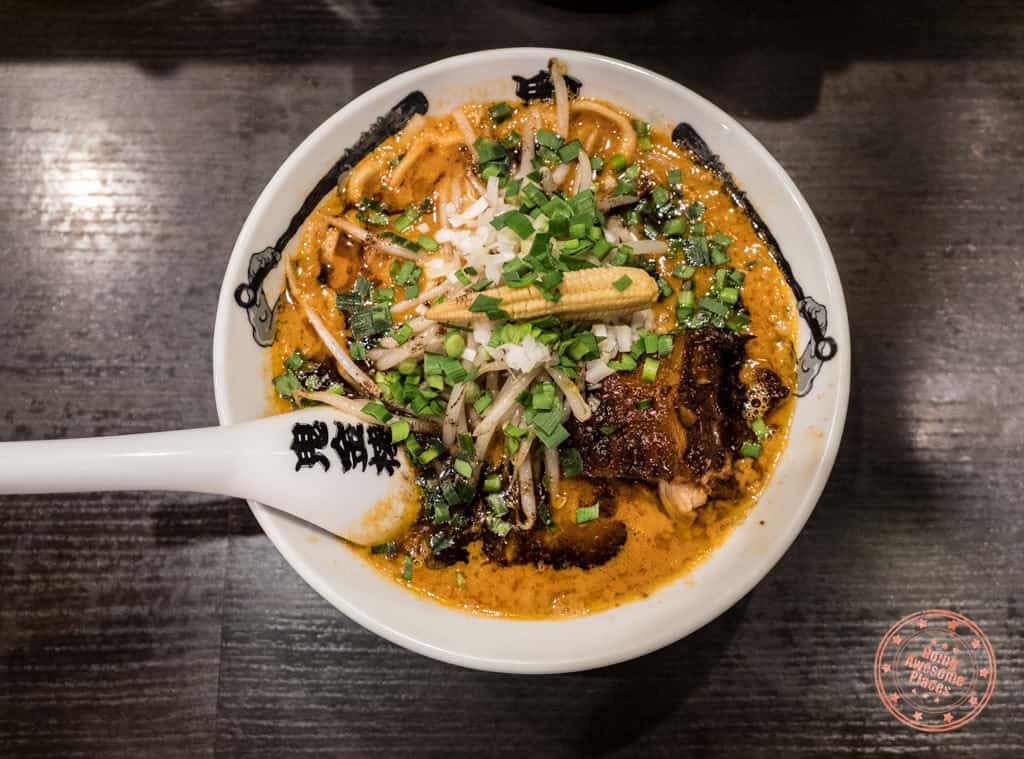
Splashed with a deep dark black paint, accented with black wood, blood red lit against a wall of Japanese demons and ogres, taiko drums blast through the speakers on relentless repeat and bludgeoning weapons dangling above each seat as if foreshadowing a not-so-distant future.

Kikanbo means “spiked bat” in Japanese and is usually wielded by a demon/ogre known as an Oni in folklore. If there’s any ramen shop out there that goes all-in with a theme, it’s this one. The menacing projection of fear and deathly spice is inescapable as soon as you’re at its doorstep.

The spice levels are broken down into two types. On one column is the chilli peppers and the other, the sansho peppers. Chilli peppers are what give it the traditional spice flavours while the sansho peppers and oils are what cause that mouth-numbing feeling.
If this is your first time, I recommend that you try the “regular” level which is medium chilli and medium sansho. When you get seated, they’ll ask for your spice level. Just say “futsu” and you’ll be set.
Tip: You can completely customize your spices so if you want regular chilli peppers but less sansho pepper, you can order it that way.

Personally, I don’t handle spice well so I was worried how this would all go but I wanted to see how the recommended level tasted like. How did I do? Well, I definitely broke out into a mild sweat and I could feel my mouth going a bit numb which was quite amusing but I was astounded that it never got to the point where I felt like I needed to douse my mouth with milk. Futsu doesn’t set your mouth on fire even for someone that is a light-weight on spice.
So good yet so dangerous at the same time
Kikanbo serves up an innovative mix of miso and tonkotsu, making it a double soup and is what gives this bowl that creamy and rich texture. You add the spices into it, fish soup, and pork back fat, and the taste becomes even fuller and packs a mean earthy punch while at the same time not over-powering everything else. On top, you have a ton of beansprouts which balanced things out as something calm, juicy, and fresh. You’ll also find a healthy amount of crisp menma, the most massive pork belly, scallions, onions, and baby corn.
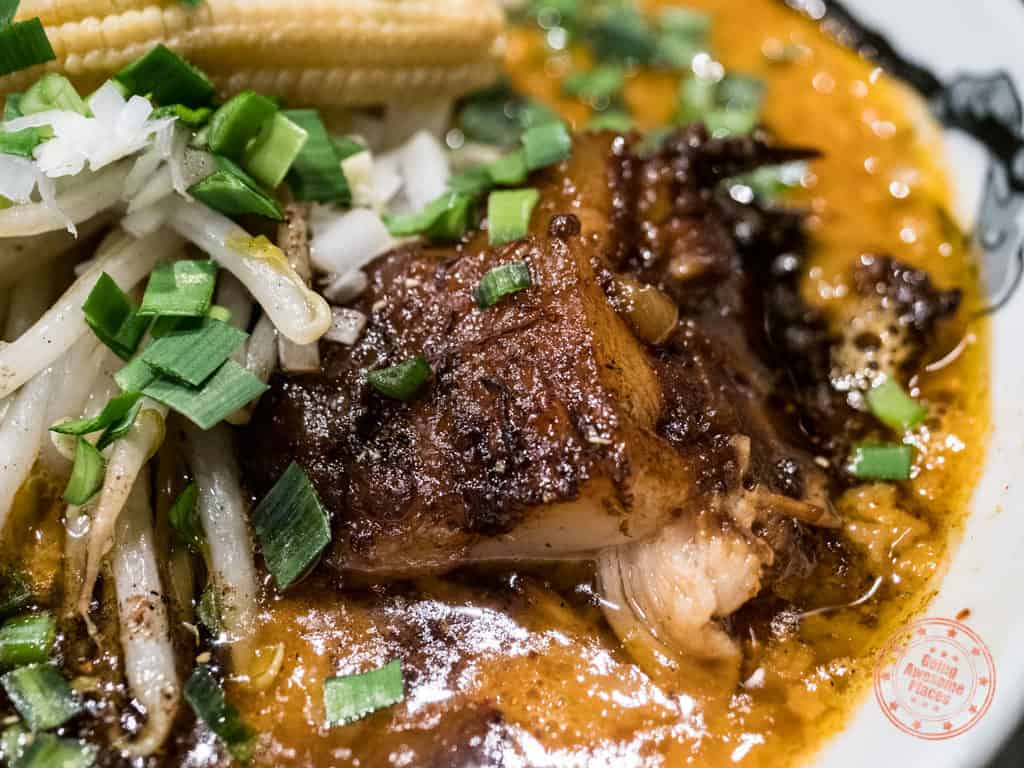
The symbolism continues throughout the bowl itself because that sweet fatty pork belly felt like almost an oasis swimming the spicy base, similar to how the beansprouts give a brief reprieve with its water. On the very top is that golden baby corn that is a final reminder of the Oni’s kikanbo ready to strike you down.
I haven’t even touched on the noodles yet which is unique in its class. Each bowl contains 3 noodle thicknesses to it which add to the chaos and gastronomically allows more soup to be gathered when you’re slurping.
Tip: If you’re a fan of their spices, this is your chance to pick up a can of it. You can easily order it on the machine afterwards.
Brave enough to try the highest level of spice, labelled as Oni-level? You’ll be served in a special iron bowl. If you survive, you’ll be given a special Oni-candy to commemorate your beast-like achievement.

Spending some time with Chef Miura, I got a chance to see all the various spices that come in different colours of powder, oil, and liquid form. Each with a specific purpose whether it’s for aroma, heat, or numbing. They’re blended together depending on the level.

Lastly, I got to ask how many people a day do the Oni-level. Miura-san said that about 15-20 do the high-level spice and roughly 3 do the Oni-level a day.
I came out of Kikanbo just completely blown away with how complete the experience is for all the senses and the branding you see is so on-point. Miura-san said he wanted to create a ramen experience that embodied the idea of Kikanbo. I’d say he’s done that exceptionally well.
What You Need To Know
Opened: 2009
Ramen master: Miura-san (not often at the restaurant)
Seats: 15

Neighbourhood: Kanda
Open hours: Mon-Sat 11AM-9:30PM, Sun 11AM-4PM
Best time to go: As with the rest, showing up before opening, late afternoon, or late evening. 4PM-6PM is also a quieter time to go
Address: 2-chōme-10-9 Kajichō, Chiyoda City, Tōkyō-to 101-0044, Japan
Closest metro station: Kanda Station
Price: Original ramen (880 JPY – $8.00 USD), original ramen with egg (980 JPY – $8.91 USD)
English menu?: Yes (most labels and signs are bilingual)
Ordering machine: Bills up to 10,000 JPY accepted, well labelled with English translations and pictures supplied
What to order: Spicy miso with Tonkotsu called “Original ramen”
Photography: Standard etiquette applies
5. Matador (牛骨らぁ麺マタドール本店)


On the outer fringes of the city is a ramen shop where the silhouette of a matador draws you in with its cape. Stepping inside is a tiny 8-person bar, all with prime view of the master inviting you to his ramen workshop.
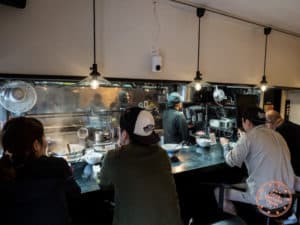
In full view of every step of the bowl’s construction, you’ll see the roast beef sliced, noodles boiled to perfection and strained with a flashy elegance, soup and shoyu combined, and toppings carefully placed.
Even if you’ve only been to a few ramen spots in your lifetime, you may have wondered why beef is never on the menu whether it comes to the soup base or toppings. The reason is two fold.
For one, it’s never been traditionally part of ramen so it’s not something that most associated to this dish. As ramen masters have become more creative, beef has been brought into the mix but to get it right is incredible difficult.
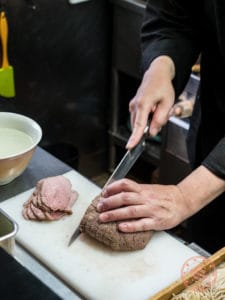
What makes beef or gyukotsu ramen difficult to pull off is because of the overpowering nature of beef and icky sweetness. With a completely different taste profile, the beef bone broth needs to be balanced with the right type of shoyu, noodle texture, and slices of beef used on top.
This spot is perfect for non-pork eaters
This bowl of beef ramen is so unique because you can instantly taste how different it is from any other bowl of ramen you’ve ever had. It’s immediately sweeter than your average ramen, but doesn’t feel out of place especially with the shoyu blended in. You then have the 3 beef slices of roast beef perfectly staggered in a fan that is meant to be slightly on chewy and textured. The biggest surprise of all is the beef ankle brisket marinated in a thick and sweet sauce to further balance out the beef.
Tip: Since it’s a cut of medium roast beef that’s placed on the soup, remember to not let it sit too long. Bite into it early and see how it changes with time.

You’ll find the noodles here a little thinner and if you end up ordering the ajitama, it’s was one of my favourites – firm outside and an orange golden gooey inside.
I think it’s time to hop on the beef ramen bandwagon!
What You Need To Know
Opened: 2011
Ramen master: Iwatate-san
Seats: 8

Neighbourhood: Kitsenju
Open hours: Tues-Sat 11:30AM-2:30PM, 6PM-9PM, Sun 11:30AM-4PM. Closed Monday
Best time to go: As with the rest, showing up before opening, late afternoon, or late evening
Address: Japan, 〒120-0025 Tōkyō-to, Adachi City, Senjuazuma, 2-chōme−4−17 中村ビル 1F
Closest metro station: Kitasenju Station
Price: Shoyu beef ramen (900 JPY – $8.18 USD), shoyu ramen with egg (1050 JPY – $9.54 USD)
English menu?: No
Ordering machine: Bills up to 2,000 JPY accepted. Machines are all in Japanese but do have pictures on them
What to order: Shoyu beef ramen with egg
Photography: Standard etiquette applies
Rosetta Stone Japanese is an easy-to-use app to learn Japanese on the go and is focused on everyday language as opposed to grammar and rules.
6. Fuunji (風雲児)

Tsukemen is the ramen of summer. It’s also a dipping noodle where you get a plate of cold noodles and a bowl of thick soup. It’s ramen with a twist.
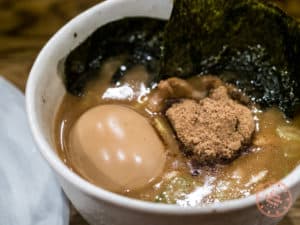
Fuunji has grown to critical acclaim over the past few years and is a big reason for the giant queues that form across the street every day. Ramen master, Miyake-san, uniquely never apprenticed at any other shop which is rare in this industry. His love of ramen propelled him to create his own style which ended up being a very killer tsukemen.
The inside of the restaurant is long and narrow with Miyake-san and his assistants frantically trying to keep pace with the fast turnover of guests. Unlike some of the others, this shop has a homely feel to it with its dim lighting, well-worn wood, and a giant wall of fame.
It’s a ramen master pump-fake
The star performer of the shop has to be Chef Miyake who sets a 4:20 timer after he drops in the noodles into a bubbling pot of hot water. When the alarm rings, he jumps back as if it’s the end of the world and swiftly drags the dipping noodles into the adjacent cold bath and spins the noodle strainer basket back towards the front and pours each one into prepared ramen bowls while spinning the baskets back the other direction as he pivots back around. It’s a ninja pump-fake as he clenches the rotating basket just in time for it to hook back into resting position.
Once the daze of watching the careful choreography is over, it’s time to enjoy the chicken with gyokai (fish) tsukemen.

First let’s start with the noodles. Cold on its own, it’s boiled to the right balance of eggy flavours, bounce, and has a slick texture.
Next to it is your bowl of soup. Thickened to a slurry, it’s topped with a generous dollop of fish powder, nori (seaweed), ajitama (egg), menma, and chashu.
Once you mix it all in together, the chicken-only soup meshes with the fish flavours and blows you away with the layers of texture and umami. It’s a mouthwatering broth that is the right amount of salty, fishy, fatty, and pork and chicken flavours.

Bring in the noodles, let them soak in the soup, and slurp them in to massive satisfaction.
I’ve had tsukemen at Rokurinsha on Tokyo Station’s Ramen Street and I thought it was average but this one is truly in a league of its own.
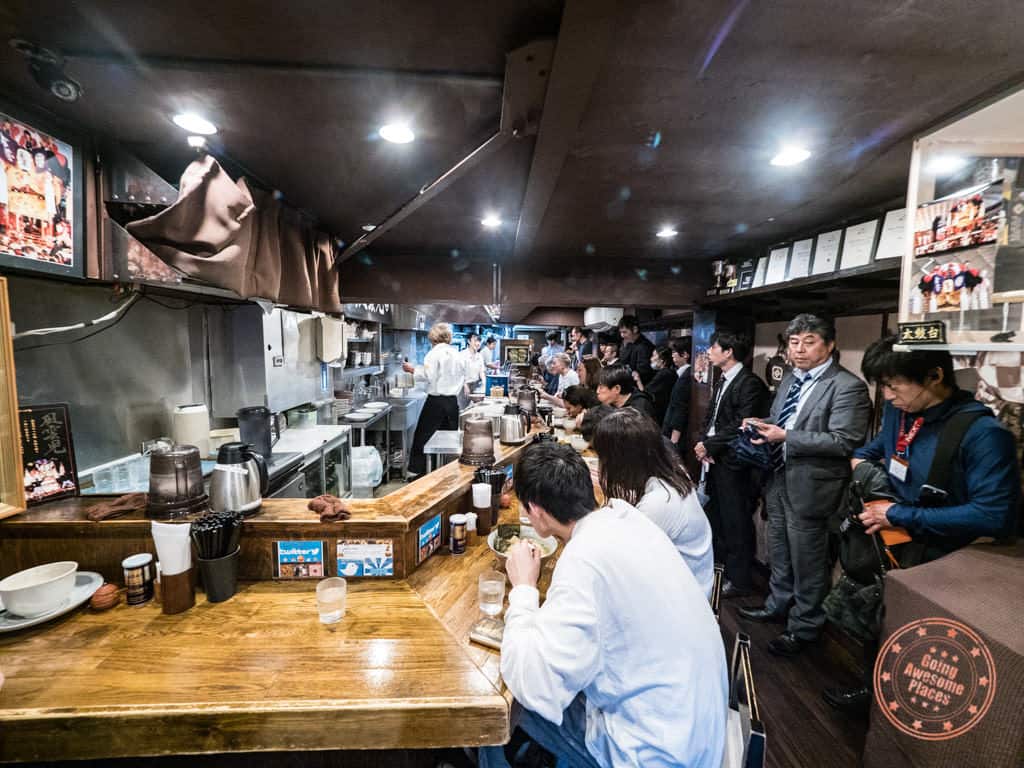
Tip: What’s unique about this shop is that the queue begins inside the restaurant behind the seats so while you eat you’ll most likely have hungry vultures peering in and wondering when you’re going to leave.
What You Need To Know
Opened: 2011
Ramen master: Miyake-san
Seats: 15
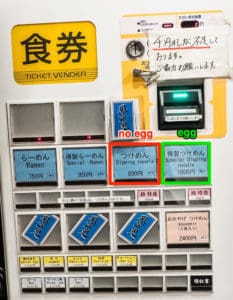
Neighbourhood: Shinjuku
Open hours: 11AM-3PM, 5PM-9PM. Closed Sunday and Holidays
Best time to go: This one is extremely popular for foreigners so show up 30 minutes before opening is your best bet
Address: Japan, 〒151-0053 Tōkyō-to, Shibuya City, Yoyogi, 2-chōme−14−3 北斗第一ビル1F
Closest metro station: Shinjuku Station
Price: Tsukemen (800 JPY – $7.27 USD), tsukemen with egg (1000 JPY – $9.09 USD)
English menu?: No
Ordering machine: Only 1,000 JPY bills accepted. There are English translations on buttons
What to order: Tsukemen (dipping noodles)
Photography: Standard etiquette applies
7. Kagari (銀座篝)

Down a discreet alleyway in the posh neighbourhood of Ginza is a backstreet that is lined with hidden restaurants. One of those joints is a ramen shop called Ginza Kagari Honten.

They opened in 2013 with huge fanfare and eventually caught the attention of Michelin as well in 2016 and 2017. Mysteriously, they vanished in November 2017. While they spun off new branches in places like Kamakura and Osaka, it was the original location that everyone wanted. There was a second Ginza location as well but even that closed in 2018. Then all of a sudden, Kagari came back.
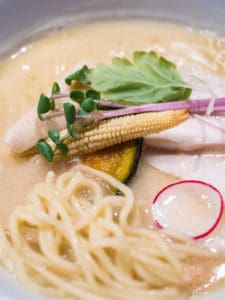
They are known for a specific type of ramen called tori-paitan. Experts, including Hiroshi from Ramen Beast say that they make the best of its kind in Tokyo. This ramen is a creamy chicken base that’s made from simmering a large vat chicken carcasses and bones long and slow to create that thick broth. Top that with a medley of refreshing vegetables, and superb noodles and you have one epic bowl of ramen.
This is creamy AF
The tori-paitan is served with a side plate of ginger and fried onions. The table will also have rice vinegar and spices. The idea is to eat the ramen as is to start but midway through, you add the sides and condiments to slowly change its flavour.
The menu is quite extensive with alternative shoyu-based tori-paitan, chicken ramen, tsukemen, and fancy toppings like truffle.
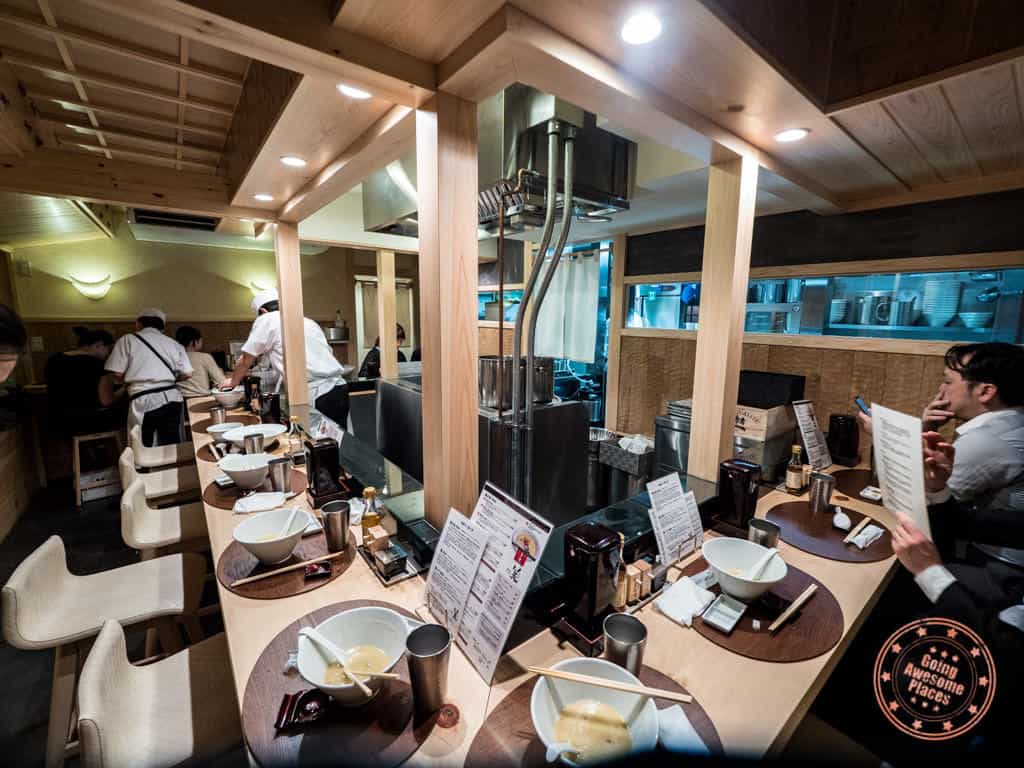
The exterior is reminiscent of a teahouse with its birch wood panels and this is threaded through the inside of the ramen shop as well. With tables that wrap around the centre in a U-shape, you get to see one of the assistants work a few big pots that I can only presume are part of the broth. In a room behind is where the ramen is prepared. This means you can’t really see what’s happening in the kitchen but you can see the heads bobbing behind the landscape window.
One thing I really appreciate about Kagari is how good they were about having English signage inside and out. The menu is easy to read, there are descriptions for each type of ramen they serve, and they also have instructions on how to eat it.
Tip: The restaurant is hard to find because it’s literally through an alleyway that doesn’t seem to lead to anywhere. If you Google Kagari, you might also be lead astray because of the old location. Even the new location is pinned incorrectly but I’ve corrected it in the map that you can get access by becoming an Insider in the form below.
What You Need To Know
Opened: 2013 and re-opened at the end of 2018
Seats: 17

Neighbourhood: Ginza
Open hours: 11AM-3:30PM, 5:30PM-10PM. Their day off changes every month, so people has to check their Twitter or IG
Best time to go: Come 30 minutes before opening or late afternoon or evening
Address: 6-4-12 Ginza, Chuo-ku, Tokyo
Closest metro station: Ginza Station
Price: Tori Paitan (1,000 JPY – $9.09 USD)
English menu?: Yes
Ordering machine: Only credit cards accepted. Orders are taken by waitress inside
What to order: Chicken Pai-Tan SOBA
Photography: Standard etiquette applies
8. Musashiya (武蔵家)
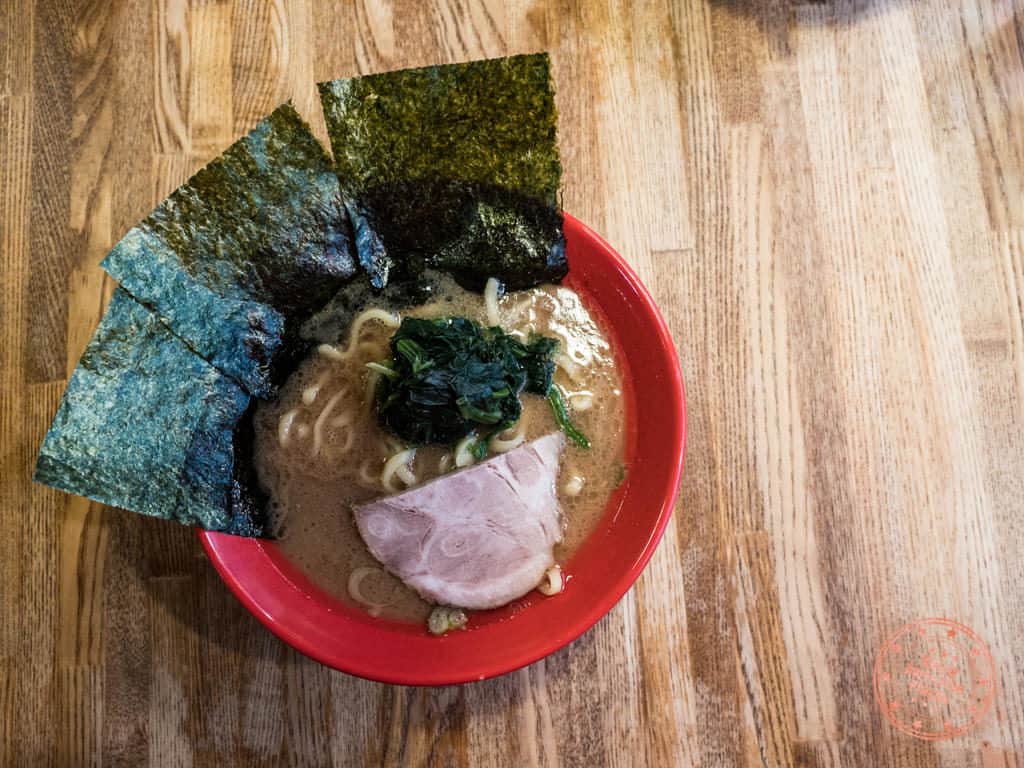
For the last ramen shop in the line up, you have to venture out to the hippest neighbourhood in Tokyo. If you’ve read the Kichijoji street food guide, you’ll know that it’s worth making a day trip out there. Another good reason to go is to try the unique style of Iekei ramen at Musashiya which you can add to your itinerary.

With loud Japanese pop playing in the background, Musashiya is a very spacious ramen shop compared to all of the others in Tokyo. It also feels more local and approachable with its street-food style decor and rustic character.
Iekei or Yokohama-style ramen is a mix of both shoyu and tonkotsu which makes it very creamy and rich. It’s topped with chashu, leek, spinach, and seaweed. What stands out from this is the spinach which you don’t often see but it goes amazingly well with the soup.
You’ll finally have some real greens in this bowl
Another unique quality of Iekei ramen is that you can choose the thickness of broth, oiliness and firmness of the noodles. For my first time, I went with the standard level for each category or simply futsu. The staff will ask you for your preference after you hand them your ramen tickets.
On the counter you will also find minced garlic, pickled vegetables, ginger, and other condiments which are very typical for this type of ramen.

While I can’t say that this is the best Iekei in the city, I was pleasantly surprised by the firmness of the noodles which makes it chewier and gives a nice bounce to balance out what is an oilier soup. The spinach finally brings some real greens to ramen which I quite enjoyed.
What You Need To Know
Opened: 1999
Ramen master: Fujisaki-san
Seats: 18

Neighbourhood: Kichijoji
Open hours: Mon-Sat 11AM – 1:30AM, Sun 11AM – 12:30AM
Best time to go: Outside of primary meal times and store opening time
Address: 1-8-11 Yayoi-building 1F, Kichijoji, Minami-mati, Musashino-shi, Tokyo
Closest metro station: Kichijoji JR Station
Price: Ramen (700 JPY – $6.36 USD)
English menu?: No
Ordering machine: Only bills up to 2,000 JPY accepted
What to order: Iekei-style (Yokohama) ramen
Photography: Standard etiquette applies
Final Tokyo Ramen Verdict
The more ramen I had in Tokyo, the more I realized how incredibly difficult it is to pick an absolute best one. If it were all the exact same type of ramen in a cook-off reality TV show, then it would be a lot easier but the truth is, I loved every single bowl we had.
Ultimately it’s really more about what tantalizes your taste buds and figuring out what you prefer. Is it tsukemen that you love or is it clear chicken soup, greasy creamy soup, or spicy as hell soup that you like?
If you put me on the spot, I think I’d have to go with the rankings that I have above and that means that Konjiki Hototogisu is right at the top as a must-visit ramen restaurant.
Seriously though, you should just try to have as many of these as you possibly can. You’ve been challenged!
A Quick Tokyo Travel Guide

If you haven’t read the Tokyo Food Guide yet, I highly recommend it because it has the meat of what you’ll find here. Instead of rehashing everything, I’ve picked out the relevant bits when it comes to building your very own ramen tour during your time in Tokyo.
Here are the travel tips and tricks you should definitely think about as you’re putting together your itinerary to slurp away at the best ramen shops in Tokyo.
Money – When it comes to your personal ramen tour in Tokyo, cash is the only thing that’ll work in the ordering machines so make sure you’re stocked up in 1,000 and 2,000 JPY bills. If you have a lot of big bills in your wallet, make sure you break them ahead of time.
When is the best time? – If you’re talking about ramen, there’s no specific “season” so really any time is good but be mindful of individual store closures as most close on Monday. The only other caveat is you probably want to avoid national holidays because that’s when there are more people available to build those epic-ly long queues. From a travel perspective, shoulder seasons are always best unless you really want to see something specific like the cherry blossoms or the Obon Festival.
Getting here – Tokyo is lucky to have two international airports serving it – Narita (NRT) and Haneda (HND). Between the two, my preference is towards Haneda because it’s closer to the city thanks to the monorail. To put alerts on the flights and find the best deals, I recommend using Skyscanner.
How do I get around Tokyo? – I’m glad you asked! I wrote a special article to cover just that topic and I actually cover it quite well in the food guide as well. My recommended way of getting around? I have to say that I really loved getting around with an IC card like Suica (PASMO is essentially the same) and just loading it up 1,000 JPY at a time. The easiest way to get a Suica card is to go to a transit machine at the airport. There are usually English-speaking helpers there and they’ll help you purchase one. Just keep in mind that there’s a 500 JPY deposit which you can get back if you return the card at a station. When you return, they’ll also deduct up to 220 JPY if there’s any balance yet so try to use it all up if you can.
NEW AS OF SEPT 2019: They’re going to be introducing a “Welcome Suica” card that doesn’t have a deposit fee but expires within 28 days which will be perfect for most visitors and will be available in various pre-set amounts. It starts at 1,000 JPY and goes all the way up to 10,000 JPY.
TIP: If you’re an organization freak like I am, you may want to look at having everything ordered online before your trip. You can do this by buying your Suica ahead of time and picking it up at the airport, or have it shipped to your door, though expect to pay a premium for the convenience.
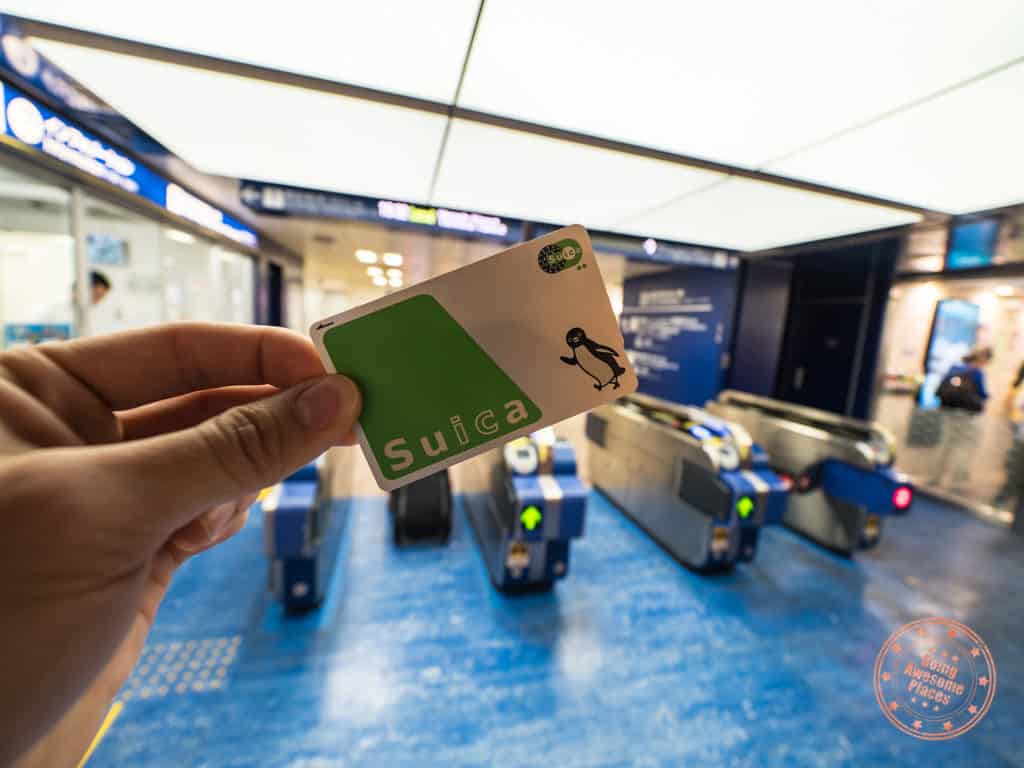
Where should I stay? – The most comprehensive platform for bookings based on personal experience was Booking.com. They had everything from hotels, hostels, and guesthouses and we always managed to find an awesome place for a great place. As an alternative, there’s also Agoda, Airbnb, and VRBO.
BUDGET

A new hostel that opened in 2017 and only a 5 min walk from Oshiage Station by Tokyo Skytree. This hostel has capsule-style rooms which are super cheap but twin rooms are also available. Complimentary coffee, tea, and wifi are offered. Keep in mind bathrooms are shared.
SOLID PICK

Steps away from Higashi-shinjuku station, this property is at quite an affordable price for its location. Rooms are small but not uncommon in Tokyo. Each room has a private bathroom fitted with a bath and a hair dryer and rooms also boast free WiFi.
LARGE GROUPS

Travelling in a larger group of 4-6? You might want to consider an Airbnb like we did on our most recent trip. It’s tight quarters here but very affordable especially when you consider that we would’ve needed 2 rooms at a minimum for 6. Came with a free wifi hotspot which was handy.
MY TOP PICK
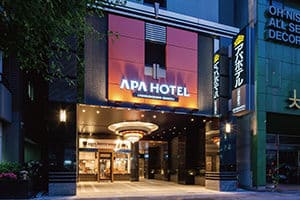
APA HOTEL ASAKUSABASHI-EKIKITA
Relatively new hotel under the APA Hotel chain that opened in 2015 that’s close to all of the major stations in Akihabara. Rooms are basic but they all have en-suite bathrooms, wifi is free, and the staff are friendly.
Do I need travel insurance? – While ramen isn’t exactly a risky activity, with travel the motto is that you never know what’s going to happen. My philosophy is that you want to make sure you’re covered in case the unknown happens. Make sure to read our guide on choosing the right travel insurance for you. Overall, World Nomads is one that’s mentioned by avid travelers.
Looking to bring some ramen home?
I’m going to tell you now that you’re going to be craving ramen from Tokyo once you go home.
The Japan souvenir guide covers all the things you need to buy before you leave Tokyo but don’t forget to buy the exclusive instant ramen bowls from Konjiki Hototogisu, Tsuta, and Nakiryu.
You can also find Ichiran everywhere in Tokyo and while not quite as good as the others, is still a great option.
Are you a ramen lover? If you’ve been to Tokyo, what have your favourites been? If you’re heading to Tokyo soon, do you have any questions? Drop a comment down below.
What you should read next
